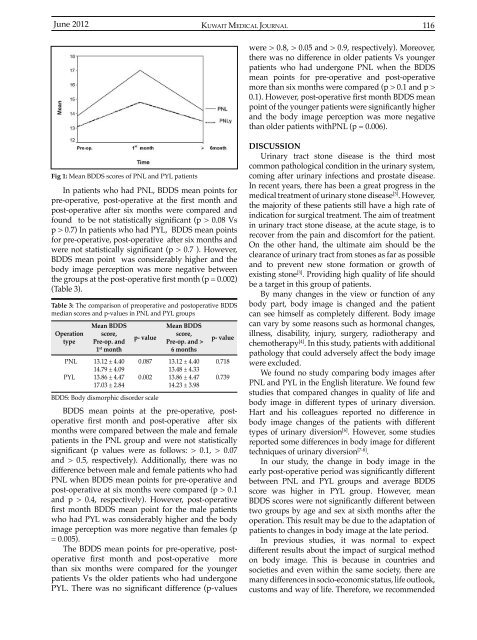Vol 44 # 2 June 2012 - Kma.org.kw
Vol 44 # 2 June 2012 - Kma.org.kw
Vol 44 # 2 June 2012 - Kma.org.kw
You also want an ePaper? Increase the reach of your titles
YUMPU automatically turns print PDFs into web optimized ePapers that Google loves.
<strong>June</strong> <strong>2012</strong><br />
KUWAIT MEDICAL JOURNAL 116<br />
were > 0.8, > 0.05 and > 0.9, respectively). Moreover,<br />
there was no difference in older patients Vs younger<br />
patients who had undergone PNL when the BDDS<br />
mean points for pre-operative and post-operative<br />
more than six months were compared (p > 0.1 and p ><br />
0.1). However, post-operative first month BDDS mean<br />
point of the younger patients were significantly higher<br />
and the body image perception was more negative<br />
than older patients withPNL (p = 0.006).<br />
Fig 1: Mean BDDS scores of PNL and PYL patients<br />
In patients who had PNL, BDDS mean points for<br />
pre-operative, post-operative at the first month and<br />
post-operative after six months were compared and<br />
found to be not statistically significant (p > 0.08 Vs<br />
p > 0.7) In patients who had PYL, BDDS mean points<br />
for pre-operative, post-operative after six months and<br />
were not statistically significant (p > 0.7 ). However,<br />
BDDS mean point was considerably higher and the<br />
body image perception was more negative between<br />
the groups at the post-operative first month (p = 0.002)<br />
(Table 3).<br />
Table 3: The comparison of preoperative and postoperative BDDS<br />
median scores and p-values in PNL and PYL groups<br />
Operation<br />
type<br />
PNL<br />
PYL<br />
Mean BDDS<br />
score,<br />
Pre-op. and<br />
1 st month<br />
13.12 ± 4.40<br />
14.79 ± 4.09<br />
13.86 ± 4.47<br />
17.03 ± 2.84<br />
p- value<br />
0.087<br />
0.002<br />
BDDS: Body dismorphic disorder scale<br />
Mean BDDS<br />
score,<br />
Pre-op. and ><br />
6 months<br />
13.12 ± 4.40<br />
13.48 ± 4.33<br />
13.86 ± 4.47<br />
14.23 ± 3.98<br />
p- value<br />
0.718<br />
0.739<br />
BDDS mean points at the pre-operative, postoperative<br />
first month and post-operative after six<br />
months were compared between the male and female<br />
patients in the PNL group and were not statistically<br />
significant (p values were as follows: > 0.1, > 0.07<br />
and > 0.5, respectively). Additionally, there was no<br />
difference between male and female patients who had<br />
PNL when BDDS mean points for pre-operative and<br />
post-operative at six months were compared (p > 0.1<br />
and p > 0.4, respectively). However, post-operative<br />
first month BDDS mean point for the male patients<br />
who had PYL was considerably higher and the body<br />
image perception was more negative than females (p<br />
= 0.005).<br />
The BDDS mean points for pre-operative, postoperative<br />
first month and post-operative more<br />
than six months were compared for the younger<br />
patients Vs the older patients who had undergone<br />
PYL. There was no significant difference (p-values<br />
DISCUSSION<br />
Urinary tract stone disease is the third most<br />
common pathological condition in the urinary system,<br />
coming after urinary infections and prostate disease.<br />
In recent years, there has been a great progress in the<br />
medical treatment of urinary stone disease [3] . However,<br />
the majority of these patients still have a high rate of<br />
indication for surgical treatment. The aim of treatment<br />
in urinary tract stone disease, at the acute stage, is to<br />
recover from the pain and discomfort for the patient.<br />
On the other hand, the ultimate aim should be the<br />
clearance of urinary tract from stones as far as possible<br />
and to prevent new stone formation or growth of<br />
existing stone [3] . Providing high quality of life should<br />
be a target in this group of patients.<br />
By many changes in the view or function of any<br />
body part, body image is changed and the patient<br />
can see himself as completely different. Body image<br />
can vary by some reasons such as hormonal changes,<br />
illness, disability, injury, surgery, radiotherapy and<br />
chemotherapy [4] . In this study, patients with additional<br />
pathology that could adversely affect the body image<br />
were excluded.<br />
We found no study comparing body images after<br />
PNL and PYL in the English literature. We found few<br />
studies that compared changes in quality of life and<br />
body image in different types of urinary diversion.<br />
Hart and his colleagues reported no difference in<br />
body image changes of the patients with different<br />
types of urinary diversion [6] . However, some studies<br />
reported some differences in body image for different<br />
techniques of urinary diversion [7-8] .<br />
In our study, the change in body image in the<br />
early post-operative period was significantly different<br />
between PNL and PYL groups and average BDDS<br />
score was higher in PYL group. However, mean<br />
BDDS scores were not significantly different between<br />
two groups by age and sex at sixth months after the<br />
operation. This result may be due to the adaptation of<br />
patients to changes in body image at the late period.<br />
In previous studies, it was normal to expect<br />
different results about the impact of surgical method<br />
on body image. This is because in countries and<br />
societies and even within the same society, there are<br />
many differences in socio-economic status, life outlook,<br />
customs and way of life. Therefore, we recommended
















